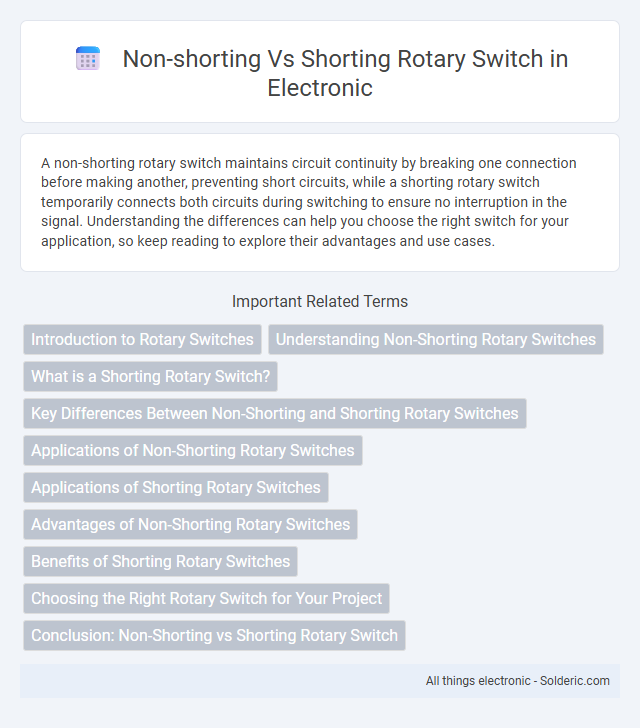A non-shorting rotary switch maintains circuit continuity by breaking one connection before making another, preventing short circuits, while a shorting rotary switch temporarily connects both circuits during switching to ensure no interruption in the signal. Understanding the differences can help you choose the right switch for your application, so keep reading to explore their advantages and use cases.
Comparison Table
| Feature | Non-Shorting Rotary Switch | Shorting Rotary Switch |
|---|---|---|
| Contact Action | Breaks circuit before making new connection | Makes new connection before breaking old one |
| Application | Used where circuit isolation is needed between positions | Used for signal switching and applications requiring overlap |
| Electrical Noise | Less chance of signal glitches or noise | Potential for brief shorts emitted during switching |
| Switching Speed | Suitable for slower, deliberate switching | Allows smoother transitions ideal for sensitive electronics |
| Risk of Damage | Lower risk due to no overlapping contacts | Possible risk if circuit can't tolerate momentary shorts |
| Common Uses | Power isolation, mode selection | Audio mixing, multi-input selectors |
Introduction to Rotary Switches
Rotary switches offer multiple positions to control circuits by rotating a knob or shaft. Non-shorting rotary switches maintain disconnection between contacts as you switch positions, preventing unintended circuit connections. Shorting rotary switches briefly connect adjacent contacts during transition, useful for applications requiring a momentary connection to avoid glitches in Your control system.
Understanding Non-Shorting Rotary Switches
Non-shorting rotary switches, also known as break-before-make switches, ensure that the current connection is broken before a new one is made, preventing accidental shorts during switching. This design protects sensitive circuits by avoiding simultaneous contact between positions, which is critical in applications requiring circuit isolation and safety. Your choice of a non-shorting rotary switch can improve reliability and prevent damage in electronic systems by maintaining clear, discrete connections.
What is a Shorting Rotary Switch?
A shorting rotary switch, also known as make-before-break, momentarily connects the current contact before disconnecting the previous one, preventing circuit interruptions during switching. This design ensures seamless transitions and is ideal for audio equipment or signal routing where uninterrupted connectivity is crucial. Your choice between shorting and non-shorting rotary switches depends on the need to maintain continuous circuit flow without brief breaks.
Key Differences Between Non-Shorting and Shorting Rotary Switches
Non-shorting rotary switches prevent electrical contact between circuits during switching, ensuring your devices do not experience brief interruptions or unwanted connections, which is critical for precise control applications. Shorting rotary switches create a brief connection between circuits at each switching point, allowing for smooth transitions and preventing signal loss in audio or signal routing systems. Understanding these key differences helps you select the appropriate switch type for reliable circuit performance and system protection.
Applications of Non-Shorting Rotary Switches
Non-shorting rotary switches are ideal for applications requiring a break-before-make action, preventing accidental short circuits when switching between positions. These switches are commonly used in audio equipment, instrumentation, and control panels where signal integrity and circuit protection are critical. Your choice of a non-shorting rotary switch ensures safe and reliable operation by temporarily disconnecting the current path during position changes.
Applications of Shorting Rotary Switches
Shorting rotary switches are commonly used in electronic circuits to ensure a predictable and reliable break-before-make mechanism, which prevents signal overlap during switching. These switches are ideal for applications requiring safe disconnection and signal isolation, such as audio equipment, test instruments, and communication devices. Their design minimizes transient signals and noise, making them suitable for sensitive signal routing and multiplexing tasks.
Advantages of Non-Shorting Rotary Switches
Non-shorting rotary switches offer the advantage of preventing momentary circuit connections during switching, which protects sensitive electronics from voltage spikes and potential damage. By breaking the connection before making a new one, these switches enhance circuit longevity and reliability in applications requiring precise control. Their design minimizes the risk of unintended current pathways, making them ideal for audio equipment, instrumentation, and other low-voltage systems.
Benefits of Shorting Rotary Switches
Shorting rotary switches provide reliable and rapid circuit disconnection by momentarily creating a short circuit when switching positions, ensuring minimal contact bounce and enhanced signal integrity. They protect sensitive electronic components during transitions, reducing the risk of voltage spikes and noise in audio or communication systems. Their design results in improved durability and smoother operation, making them ideal for applications requiring precise and clean switching actions.
Choosing the Right Rotary Switch for Your Project
Selecting the right rotary switch depends on whether a non-shorting or shorting mechanism suits your circuit requirements, as non-shorting switches prevent momentary shorts when changing positions, ideal for sensitive electronics. Shorting rotary switches momentarily connect adjacent contacts during switching, useful for applications needing signal continuity or specific sequencing. Understanding the electrical behavior and application context ensures optimal performance and prevents potential damage in your project design.
Conclusion: Non-Shorting vs Shorting Rotary Switch
Non-shorting and shorting rotary switches differ primarily in their contact switching behavior, with non-shorting switches breaking the previous circuit before making a new connection to avoid momentary shorts. Shorting rotary switches temporarily connect the outgoing contact to the incoming contact, enabling smooth transitions in applications like audio equipment to prevent signal dropouts. Choosing the right type depends on your specific circuit needs, where non-shorting switches enhance safety by preventing shorts, and shorting switches improve continuity during switching.
non-shorting vs shorting rotary switch Infographic

 solderic.com
solderic.com